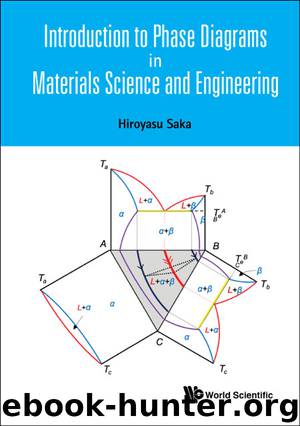Introduction To Phase Diagrams In Materials Science And Engineering by Saka Hiroyasu;

Author:Saka, Hiroyasu;
Language: eng
Format: epub
Publisher: World Scientific Publishing Company
Published: 2019-04-15T00:00:00+00:00
Fig. 2.31Mechanisms of shape-memory effect and pseudoelasticity. For , , and refer to Fig. 2.30.
Now in Fig. 2.30, linearity between σ-ε breaks down, yet on unloading a stress-strain curve retraces that on loading without leaving a permanent strain. This phenomenon is referred to as pseudoelasticity or super elasticity. The reason why a prefix “pseudo” is attached is as follows:
1) On complete unloading a permanent strain does not remain.
2) But, proportionality between σ and ε does not hold.
This seemingly magical phenomenon is accounted for by martensitic transformation. Let us discuss this phenomenon based on Fig. 2.31. On loading at temperature Af < T < Md a strain-induced martensitic transformation takes place. As a result, the outer shape of the alloy is changed (corresponding to path in Fig. 2.31). Here σM is a stress required to induce the martensitic transformation. However, under this state martensite is stable only under stress ( T > Af). Therefore, upon unloading the martensite transforms reversely back to the original high-temperature phase (corresponding to austenite) and the outer shape returns to the initial shape (corresponding to in Fig. 2.31). This is referred to as pseudoelasticity.
When Ms < T < Af′ the process on loading is the same (path ). However, in this case the martensite is stable in the absence of strain ( T < Af). Thus, on unloading the martensite phase remains without reverse-transforming back to the high-temperature phase; the change in outer shape is held. However, on heating this martensite to above Af the martensite becomes unstable and transforms reversely back to the initial high-temperature phase (path in Fig. 2.31), the outer shape of the alloy returning back to the initial shape prior to deformation. This is a shape memory effect.
When T < Ms, martensite is already formed via path . Martensite phase in a shape memory alloy contains a lot of twins inside. The martensite formed by quenching contains a pair of variant at almost equal frequency. However, on loading a variant which responds to external stress invades the counterpart (path ). Here, σI is a stress required to move an interface between the variants and much smaller than σM. On complete unloading the outer shape does not return to the initial shape. However, on heating to T > Af the martensite reverse-transforms to the high temperature phase, so does the outer shape (path in Fig. 2.31).
Download
This site does not store any files on its server. We only index and link to content provided by other sites. Please contact the content providers to delete copyright contents if any and email us, we'll remove relevant links or contents immediately.
| Automotive | Engineering |
| Transportation |
Whiskies Galore by Ian Buxton(41323)
Introduction to Aircraft Design (Cambridge Aerospace Series) by John P. Fielding(32722)
Small Unmanned Fixed-wing Aircraft Design by Andrew J. Keane Andras Sobester James P. Scanlan & András Sóbester & James P. Scanlan(32411)
Craft Beer for the Homebrewer by Michael Agnew(17760)
Turbulence by E. J. Noyes(7498)
The Complete Stick Figure Physics Tutorials by Allen Sarah(6959)
Kaplan MCAT General Chemistry Review by Kaplan(6394)
The Thirst by Nesbo Jo(6240)
Bad Blood by John Carreyrou(6112)
Modelling of Convective Heat and Mass Transfer in Rotating Flows by Igor V. Shevchuk(6073)
Learning SQL by Alan Beaulieu(5857)
Weapons of Math Destruction by Cathy O'Neil(5580)
Man-made Catastrophes and Risk Information Concealment by Dmitry Chernov & Didier Sornette(5380)
Digital Minimalism by Cal Newport;(5153)
Life 3.0: Being Human in the Age of Artificial Intelligence by Tegmark Max(4997)
iGen by Jean M. Twenge(4996)
Design of Trajectory Optimization Approach for Space Maneuver Vehicle Skip Entry Problems by Runqi Chai & Al Savvaris & Antonios Tsourdos & Senchun Chai(4696)
Secrets of Antigravity Propulsion: Tesla, UFOs, and Classified Aerospace Technology by Ph.D. Paul A. Laviolette(4539)
Electronic Devices & Circuits by Jacob Millman & Christos C. Halkias(4519)
